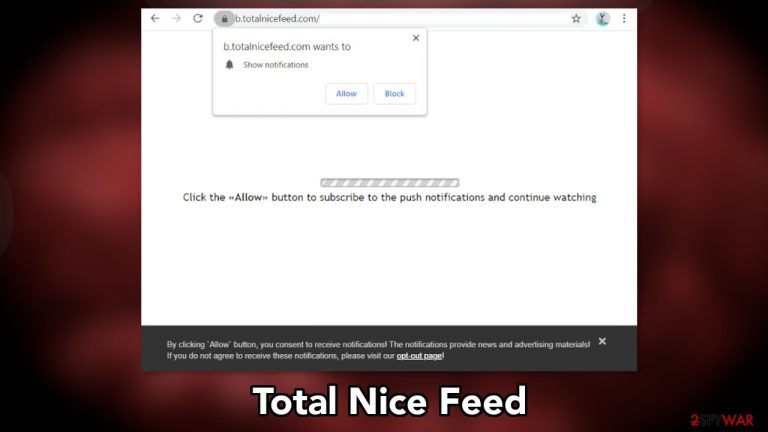Total Nice Feed ads (spam) - Free Guide
Total Nice Feed ads Removal Guide
What is Total Nice Feed ads?
Total Nice Feed starts spamming users with annoying push notifications after they click “Allow”

Total Nice Feed is a bogus website that appears when users are browsing through shady pages or they have adware[1] installed in their system. The page asks users to click the “Allow” button to continue watching something, so we can assume that this site is most likely promoted on illegal streaming platforms.[2]
After people grant permission for the page to send push notifications, ads start appearing in the corner of the screen, sometimes even when the browser is closed. The notification prompts can come from both – legitimate and shady sources, so it is important to be careful and try not to interact with them until you remove them.
Ads that you see may contain controversial images, messages that make you want to investigate and click on them. They might offer amazing deals and big discounts but you have to fight the temptation as ads that claim to sell something extraordinary are most likely fake and lead to dangerous sites.
The Internet is still full of scam sites that use social engineering techniques, like fake giveaways, software updates, surveys, virus infection warnings to get your personal information or trick you into downloading PUPs (potentially unwanted programs)[3] or malware.
| NAME | Total Nice Feed |
| TYPE | Push notification spam; adware |
| SYMPTOMS | Pop-up ads start appearing in the corner of the screen sometimes even when the browsing is not in-use |
| DISTRIBUTION | Shady websites, deceptive ads, freeware installations |
| DANGERS | Pop-ups can contain links leading to dangerous websites where users could get tricked into providing their personal information or downloading PUPs and malware |
| ELIMINATION | Go to your browser settings to disable notifications; scanning your system with anti-malware tools is recommended |
| FURTHER STEPS | Use FortectIntego to get rid of any remaining damage and clear your browsers completely |
Because push notifications are based on a subscription model, only users themselves can enable and disable them. So the appearance of them is most of the time users' own fault. People rush, do not read privacy policies, click on random buttons just to get what they want faster. Even though many say they care deeply about their online security and privacy, only a few actually take precautionary steps to preserve it.
Push notification spam page distribution
It is very rare for users to find sites like Total Nice Feed in the search results. Most of the time they get redirected to them after they click on a deceptive ad on a shady site. For example, illegal streaming platforms are full of fake “Download” and “Play” buttons.[4] Even though Google said it would get rid of them, they still exist and fool users every day.
It is easy to get tricked by the scheme if you are looking for a movie or TV show to watch. You click on a button to play it and a new tab opens saying you need to press one button to watch it. Many people may not even realize that it is a completely separate page that is unrelated to the one they were previously on.
Another way you could have encountered this bogus page is because of adware. It is a type of PUA that can generate commercial content like pop-ups, banners, surveys, and redirects on your machine. The same as with the website, you could have installed it by accident while browsing through pages you should not, or downloading software from freeware[5] sites.

Freeware distributors often include additional programs in the installers and do not disclose this information. Because most people find the installation process boring, they skip through all the steps and do not notice the PUPs they install together with the intended software.
What we suggest you do during the process is choosing the “Custom” or “Advanced” installation method, reading the privacy policy and terms of use to find out how your data is going to be used and what the app will be able to perform on your system. The most crucial part is to uncheck the boxes next to any files that look suspicious to prevent them from installing on your machine.
Start the removal by going to your browser settings
Because push notifications are based on a subscription model, only you can disable them. Follow the guide:
Google Chrome (desktop):
- Open Google Chrome browser and go to Menu > Settings.
- Scroll down and click on Advanced.
- Locate Privacy and security section and pick Site Settings > Notifications.

- Look at the Allow section and look for a suspicious URL.
- Click the three vertical dots next to it and pick Block. This should remove unwanted notifications from Google Chrome.

Google Chrome (Android):
- Open Google Chrome and tap on Settings (three vertical dots).
- Select Notifications.
- Scroll down to the Sites section.
- Locate the unwanted URL and toggle the button to the left (Off setting).

Mozilla Firefox:
- Open Mozilla Firefox and go to Menu > Options.
- Click on Privacy & Security section.
- Under Permissions, you should be able to see Notifications. Click the Settings button next to it.

- In the Settings – Notification Permissions window, click on the drop-down menu by the URL in question.
- Select Block and then click on Save Changes. This should remove unwanted notifications from Mozilla Firefox.

Safari:
- Click on Safari > Preferences…
- Go to the Websites tab and, under General, select Notifications.
- Select the web address in question, click the drop-down menu and select Deny.

MS Edge:
- Open Microsoft Edge, and click the Settings and more button (three horizontal dots) at the top-right of the window.
- Select Settings and then go to Advanced.
- Under Website permissions, pick Manage permissions and select the URL in question.

- Toggle the switch to the left to turn notifications off on Microsoft Edge.
MS Edge (Chromium):
- Open Microsoft Edge, and go to Settings.
- Select Site permissions.
- Go to Notifications on the right.
- Under Allow, you will find the unwanted entry.
- Click on More actions and select Block.
Internet Explorer:
- Open Internet Explorer, and click on the Gear icon at the top-right of the window.
- Select Internet options and go to the Privacy tab.
- In the Pop-up Blocker section, click on Settings.
- Locate web address in question under Allowed sites and pick Remove.

All of the pages that you visit use cookies[6] to track your browsing activities. Generally, this is not a bad thing as it helps websites to personalize the user experience but in some cases, it can cause a lot of issues. If the pages you visit do not have strong security, cookies can be hacked and stolen which has happened in the past. Untrustworthy pages can also sell them to advertising networks that use them to target you with ads more.
That is why it is important to clear your browser regularly. This can be automated with a maintenance tool like FortectIntego. It does not only delete all cookies and cache but can also fix system damage, errors, registry issues which is especially helpful after virus infections.
Scan the machine for adware
Once you block the notifications, there is still a chance that there is adware hiding in your system. You might still be experiencing an increased amount of commercial content like surveys, banners. You might get redirected automatically by your browser to suspicious pages. If you have any of these symptoms, we strongly suggest deploying professional security tools like SpyHunter 5Combo Cleaner or Malwarebytes to scan your machine.
They can detect suspicious processes happening in your machine and eliminate all the files causing it. What is more, it can prevent such infections in the future by warning you about a dangerous download. Of course, you can remove programs manually, but it can be difficult to identify PUPs as they can be disguised as handy tools that you use every day and would not suspect anything bad about them.
If you want to perform manual removal, you can follow the instructions posted below for Windows and Mac systems:
Windows 10/8:
- Enter Control Panel into Windows search box and hit Enter or click on the search result.
- Under Programs, select Uninstall a program.

- From the list, find the entry of the suspicious program.
- Right-click on the application and select Uninstall.
- If User Account Control shows up, click Yes.
- Wait till uninstallation process is complete and click OK.

Windows 7/XP:
- Click on Windows Start > Control Panel located on the right pane (if you are Windows XP user, click on Add/Remove Programs).
- In Control Panel, select Programs > Uninstall a program.

- Pick the unwanted application by clicking on it once.
- At the top, click Uninstall/Change.
- In the confirmation prompt, pick Yes.
- Click OK once the removal process is finished.
Mac:
- From the menu bar, select Go > Applications.
- In the Applications folder, look for all related entries.
- Click on the app and drag it to Trash (or right-click and pick Move to Trash)

To fully remove an unwanted app, you need to access Application Support, LaunchAgents, and LaunchDaemons folders and delete relevant files:
- Select Go > Go to Folder.
- Enter /Library/Application Support and click Go or press Enter.
- In the Application Support folder, look for any dubious entries and then delete them.
- Now enter /Library/LaunchAgents and /Library/LaunchDaemons folders the same way and terminate all the related .plist files.

How to prevent from getting adware
Do not let government spy on you
The government has many issues in regards to tracking users' data and spying on citizens, so you should take this into consideration and learn more about shady information gathering practices. Avoid any unwanted government tracking or spying by going totally anonymous on the internet.
You can choose a different location when you go online and access any material you want without particular content restrictions. You can easily enjoy internet connection without any risks of being hacked by using Private Internet Access VPN.
Control the information that can be accessed by government any other unwanted party and surf online without being spied on. Even if you are not involved in illegal activities or trust your selection of services, platforms, be suspicious for your own security and take precautionary measures by using the VPN service.
Backup files for the later use, in case of the malware attack
Computer users can suffer from data losses due to cyber infections or their own faulty doings. Ransomware can encrypt and hold files hostage, while unforeseen power cuts might cause a loss of important documents. If you have proper up-to-date backups, you can easily recover after such an incident and get back to work. It is also equally important to update backups on a regular basis so that the newest information remains intact – you can set this process to be performed automatically.
When you have the previous version of every important document or project you can avoid frustration and breakdowns. It comes in handy when malware strikes out of nowhere. Use Data Recovery Pro for the data restoration process.
- ^ What is Adware? – Definition and Explanation. Kaspersky. Home Security.
- ^ Victor Poitevin. Illegal streaming: beware of the backlash. Stormshield. Security Monitoring.
- ^ Chris Hoffman. PUPs Explained: What is a “Potentially Unwanted Program”?. Howtogeek. Technology Magazine.
- ^ Andy Maxwell. Google Targets Fake ‘Download’ and ‘Play’ Buttons. Torrentfreak. Filesharing News.
- ^ Tim Fisher. What Is Freeware?. Lifewire. Internet, Networking and Security Blog.
- ^ Chris Maus. What Are Cookies and Are They Dangerous?. Qkey. Secure Online Payment Provider.
